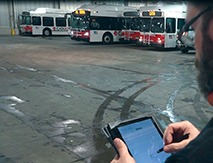Enhancing service with fleet monitoring solutions
Avail Technologies, State College, PA, is an intelligent transportation systems (ITS) solutions provider for transit operators in the United States, specializing in CAD/AVL solutions for fixed route and paratransit. In an interview with BUSRide, Rick Spangler, vice president of Customer Relations at Avail Technologies, answers a few critical questions about fleet monitoring.

What are the essential elements of a comprehensive fleet monitoring system?
As an ITS provider, we’re about providing tools to help solve tech problems. We’re constantly asking ourselves: What do our customers need and how can we tailor our tools and services to meet that need?
There are two types of users we encounter most often, internal and external users. Internal users are the transit agencies – what tools can we provide the transit agency to monitor their fleet? External users are their riders – what can technology do to enhance the rider experience?
Within the subgroup of internal users, there are many different departments at each transit agency. These can include operations, maintenance, planning, dispatch, customer service, marketing and administration.
For operations, the best fleet monitoring program provides tools that monitor the health of the service in real time. This includes everything from vehicles in use, drivers working, schedule adherence and other data.
Maintenance is concerned about the health of the fleet – so the best software also provides pre-trip monitoring, vehicle health monitoring and preventative maintenance monitoring.
Planning is focused on the overall level of service. They have to monitor running times, dwell times, passenger counts, demographics, fare collection data, etc. The best tools will help them process that data and then refine the agency’s services.

How does fleet monitoring software effectively coordinate the disparate interests at a transit agency – operations, planning, administration, etc.?
When agencies are looking for a solution, they need to be mindful of these disparate interests. Each of these departments has different specific needs to accomplish their individual goals in support of the overall agency objectives. Not having a uniform system only exasperates these differences. You need an integrated solution that ties everything together, so that operations data feeds right into planning data, which feeds right into maintenance data. The exchange of data should be seamless to enable efficient workflows within the organization.
Open architecture, the basis of Avail’s platform, is a great way to accomplish this. Any data generated by a comprehensive fleet management system can be shared with any user in the system on any tool, no matter the tool’s vendor. Many agencies have already made significant investments in software tools, and it’s unrealistic to expect them to rework their entire system to achieve seamless integration.
Software that offers “role-based” scenarios is another great way to turn data into information. One tool can serve every user in an agency, but agencies can tailor various user interfaces so that each department only receives the information necessary to do their job.
How can fleet monitoring software help operators to enhance the rider experience?
When we think about the passenger in 2015, they have far more insight to agency operations than they have in previous years. Before, they only had access to the printed schedule. Now we’re giving passengers real-time information tools that are as mobile as they are.
In some ways, the riders are now just as proactive in monitoring service as agency employees. This helps transit agencies to attract choice riders. Rather than just the transit-dependent population, agency services are being used by millennials, professionals and students. They’ve got websites and apps with real-time vehicle tracking information – and if the vehicle isn’t really where the agency says it’s going to be, those riders are the first to call that to the agency’s attention.
Real-time Passenger Information (RTPI) is a great tool to not only communicate with your riders, but also stay on top of fleet service levels. Passengers, your advocates in the field, should be able to look at a transportation center’s sign, the app on their smartphone, and be on the phone calling into the voice system – and all of the information should match. If the information doesn’t match, riders will often alert customer service agents and the issue can be addressed. This type of interaction helps make riders feel empowered and in control of their transit experience, while at the same time helping operators maintain reliable service levels.
Fleet Monitoring systems are now capable of providing answers and not just data, empowering the riders and operators in a way that keeps them ahead of the curve.
Rick Spangler serves as the vice president of Customer Relations at Avail Technologies, an ITS technology solutions provider for transit operators in the United States. Visit www.availtec.com for more information.
